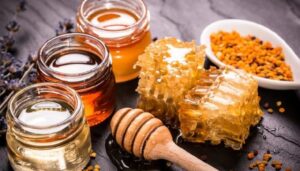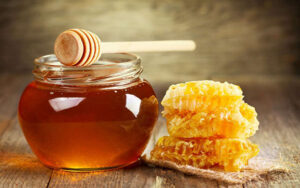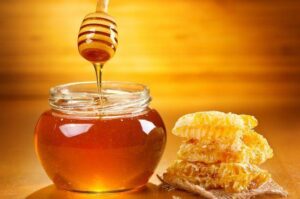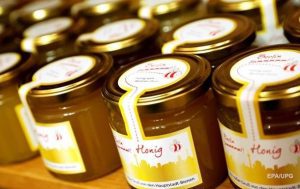
Ukraine and the People’s Republic of China have agreed on the terms of exporting Ukrainian honey to China, and now Ukrainian honey producers can supply their products to the country, the press service of the State Service of Ukraine for Food Safety and Consumer Protection reported.
“Thanks to the coordinated work of the State Service of Ukraine for Food Safety and Consumer Protection and the Ministry of Foreign Affairs, as well as with the support of the Embassy of Ukraine in the People’s Republic of China, all stages of approval of the certificate for honey exports to China have been completed. The procedure for opening the honey market in China, which began in 2019, has been officially completed and the market is open to domestic exporters,” the State Service of Ukraine for Food Safety and Consumer Protection said on Thursday.
According to the head of the service, Serhiy Tkachuk, this is the first export market that the agency opened in 2024.
“A lot of work has been done, many meetings and negotiations have been held, and the state control system in Ukraine has been audited. We plan not to stop, but to continue working to ensure the uninterrupted export of Ukrainian products in order to strengthen economic stability and increase jobs in our country,” Tkachuk emphasized.
The approved form of the health certificate for the export of honey from Ukraine to China is available on the official web portal of the State Service of Ukraine on Food Safety and Consumer Protection in the section “International Cooperation” under the heading “Certificates for export from Ukraine”.
The agency also advised potential honey exporters to familiarize themselves with the guidelines for state veterinary inspectors of Ukraine and market operators who intend to export honey to China.
“The Chinese market is very promising for the export of Ukrainian products and its opening for Ukrainian honey significantly expands opportunities for domestic producers,” the State Service of Ukraine for Food Safety and Consumer Protection expressed confidence.

Ukraine’s share in honey imports to the EU in 2022 amounted to 24%, which allowed it to take second place among exporting countries, Beehive reported on Facebook, citing data from Eurostat and the European Federation of Honey Packers and Distributors (F.E.E.D.M.).
According to the report, in addition to Ukraine, the top countries supplying honey to the EU include China (36%), Argentina (10%), Mexico (7%), Turkey (4%), Cuba and Vietnam (3% each).
According to Beehive’s preliminary forecasts, the total amount of honey exported from Ukraine in 2023 will be 5-10% higher than in 2022.
“It can be noted that Ukraine holds its position in the market and has every chance to increase the number of exports, taking away market share from other major players,” the company summarized.
As reported, the investment holding EFI Group (Effective Investments) has started selling Ukrainian honey produced by one of its companies under the Beehive brand in UK supermarkets.
Registered in 2013, Beehive LLC’s production facilities of 5 thousand square meters are located in Cherkasy region. The daily output of finished products is 40 tons. The company’s capacity is designed to produce more than 10 thousand tons of honey per year. The company has two production lines: bottling in barrels and packaging in glass containers of various volumes for retail. Honey production complies with international standards such as Organic Standard, FDA, IFS Food, FSSC 22000, and Halal.
Effective Investments Group was founded in 2007 and is engaged in the implementation of business projects in Ukraine. It operates in various sectors of the economy: agriculture, pulp and paper industry, construction, gas industry, energy, creative industry, mechanical engineering and coal industry.

In 2022 the EU countries have increased imports of honey in physical form by almost 10% – up to 190.6 thousand tons, which in money equivalent is EUR504.2 million, said honey market analyst Anna Burka in Facebook.
According to her data, the EU increased imports from China by 42%, Argentina – by 35%, as well as from Turkey and Vietnam, while imports from Ukraine decreased in kind by 14%.
“Ukraine remains one of the main suppliers of honey to the EU, but in 2022 China ranks first in the ranking (in volume terms). At the same time, if we look at imports in money terms, Ukraine is still the leader,” the analyst noted.
According to data of the European Commission, as quoted by Anna Burka, in 2022 Ukraine supplied 46.09 tons of honey to the EU, which accounted for 24.2% of total imports. A year earlier, the figure was 53.836 thousand tons, and Ukraine had a 31% share of supplies. In 2029, supplies reached 54.8 thousand tons, which was 31.3% of all EU honey imports.
Judging by the four-year trends cited by the EC, EU consumption of honey, particularly imported honey, is on the rise. While in 2019, EU countries imported 167.097 thousand tons of it, in 2020 it increased by 4.7% to 174.912 thousand tons, in 2022 imports reached 190.591 thousand tons, an increase of 9.8% over the year before.
As reported, in 2022 88% of Ukrainian honey exports accounted for the EU countries, which brought exporters $120 million.
The main buyers of Ukrainian honey were Germany, which bought it for $38 million, Poland – $24 million, France – $11 million, Italy – $7 million, Spain – $6 million, Belgium – $6 million. Among the countries from other regions that imported Ukrainian honey were the US, which bought it for $10 million and Japan – $1.7 million. Minor volumes were supplied to Turkey, Israel, Qatar, UAE, Somalia.

The cancellation by the UK of all duties and quotas on products from Ukraine to support it in the face of a military invasion by the Russian Federation may allow Ukrainian farmers to increase their presence in the UK markets of poultry meat, walnuts, honey, cranberries, blueberries and peas.
The list of high-margin agricultural products that Ukraine could supply to the UK at a time when the export of its traditional agricultural raw materials is blocked by the aggressor country of the Russian Federation was published on the website of the Ukrainian Agribusiness Club (UCAB) on Wednesday evening.
According to the results of 2021, agricultural products worth $553 million were exported from Ukraine to the UK, including sunflower oil (31% of export earnings), rapeseed (28%) and corn (24%). However, the supply of traditional agricultural crops in 2022 is difficult due to the naval blockade of Ukraine by Russian warships, as a result of which the country can potentially increase the export of a number of other agricultural products by road.
Ukrainian farmers, in particular, can focus their export efforts on the supply of poultry meat to the UK. The volume of its export in 2021 was 2,600 tonnes. The share of Ukraine of UK imports is 1%. Main competitors: the Netherlands, Poland, and Belgium.
The export of walnuts without shells is also promising. The volume of its export in 2021 was 0700 tonnes. The share of Ukraine of UK imports is 6%. Main competitors: the United States, Germany, and China.
According to the UCAB, Ukrainian farmers can increase honey exports to the UK (800 tonnes were delivered in 2021). The share of Ukraine of UK imports is 1%. Main competitors: China, Poland, and Mexico.
The export of cranberries and blueberries is also promising (supplies in 2021 – 200 tonnes). The share of Ukraine of UK imports is 0.3%. Main competitors: Spain, Peru, and Chile.
Ukraine exported 4,900 tonnes of peas to the UK in 2021, which amounted to 12% of the UK market in 2021. At the same time, Russia is Ukraine’s main competitor in this market, which, taking into account the economic sanctions imposed against it, adds an advantage to Ukrainian suppliers.
“Now the railways and seaports of neighboring countries are heavily loaded due to the export of grain crops, the volumes of which we have the largest. Therefore, to increase export earnings, we should focus on the export of goods that have a higher price with less weight and thus export by road,” UCAB cites a promising export model from its analyst Svitlana Lytvyn.
BERRIES, HONEY, PEAS, POULTRY, UK, UKRAINIAN FARMERS, WALNUTS

Export of honey from Ukraine in 11 months of 2020 reached an absolute record – 69,084 tonnes with a total value of $117.5 million, national consultant to the Food and Agriculture Organization of the United Nations (FAO) Hanna Burka has said.
“There is less than a month left before the start of the New Year 2021, but there is already a record for the export of honey. Its export from Ukraine in 11 months of 2020 reached an absolute record – 69,800 tonnes for a total of $117.5 million. The previous record was set in 2017 – 67,800 tonnes ($133.9 million),” she wrote on her Facebook page.
According to the expert, high demand for Ukrainian honey is observed from the countries of the European Union. It is due to a number of reasons: uncertainty with the further development of the situation with COVID-19, respectively, the active formation of residues for the entire 2020/21 season; poor honey harvest in the EU: according to preliminary estimates, its harvest fell by 40% due to unfavorable weather conditions.
Ukraine in 2019 exported 49,740 tonnes of honey (12 months), in 2018 – 41,740 tonnes.

The renewal of the Association Agreement between the European Union and Ukraine next year can give a new impetus to the development of the Ukrainian honey industry, strengthen the country’s position in the EU market and reduce its dependence on the supply of Chinese honey, which now forms about 40% of the total supplies in this direction, national consultant to the Food and Agriculture Organization of the United Nations (FAO) Hanna Burka has said.
Now the Ukrainian honey market depends on supplies to the European Union, whose share in the total volume of Ukrainian honey exports exceeds 80% (in 2019 – 86%, in 2018 – 80%, in 2017 – 74% ). The EU countries are considered the largest honey importers in the world and about 40% of honey needs are met by imports, she said on her Facebook page.
“The signing of the Association Agreement between Ukraine and the European Union, within the framework of which a deep and comprehensive free trade zone began to function, contributed to an increase in purchasing countries and an increase in the export of Ukrainian honey, and, accordingly, the flow of foreign exchange earnings into the country,” Burka wrote.
So, in 2017, Ukraine exported 47,100 tonnes of honey to the EU, in 2018 – 41,000 tonnes, and in 2019 – 45,000 tonnes.
“A year after the signing of the Agreement, the number of enterprises that had the right to supply honey to the markets of the European Union increased to 52, and by the end of 2019 it was 72,” the FAO consultant said.
In addition, the share of Ukraine in the import of honey to the EU countries also increased, if in 2013 it was 10%, then in 2019 it reached 22% (in 2018 – 20%, in 2017 – 23%). Accordingly, Ukraine became No. 2 supplier of honey to Europe, with China ahead.
“During the FTA, Ukrainian honey exporting companies are actively using the possibilities of duty-free tariff quotas. Both the main and additional preferential quotas for honey were used in the first days of the month. Despite the fact that the extra-quota volume is subject to an import duty of 17.3%, the export volumes of Ukrainian honey continue to increase. The current export volume is seven-eight times higher than the annual volume of the total quota, which confirms the interest of European partners in Ukrainian honey,” Burka said.
According to her, it is obvious that the current volume of the quota (in 2017, the main quota was 5,200 tonnes, in 2018 – 5,400 tonnes, in 2019 – 5,600 tonnes, in 2020 – 5,800 tonnes; additional 2,500 tonnes was not revised) does not suit both the demand of Europe and the possibilities of the Ukrainian honey industry.
“The next Ukraine-EU negotiations should be aimed at both increasing the duty-free quota and reducing customs tariffs. As an example, the EU-Mexico cooperation model can be used, for which the preferential quota is 30,000 tonnes at a rate of 8.6%,” said the expert.